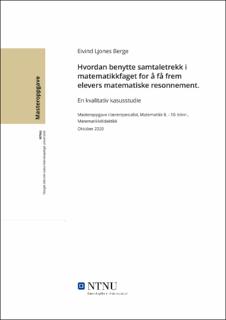| dc.contributor.advisor | Ahn Braseth, Eskil | |
| dc.contributor.author | Ljones Berge, Eivind | |
| dc.date.accessioned | 2021-09-28T17:27:01Z | |
| dc.date.available | 2021-09-28T17:27:01Z | |
| dc.date.issued | 2021 | |
| dc.identifier | no.ntnu:inspera:76122964:25284558 | |
| dc.identifier.uri | https://hdl.handle.net/11250/2784374 | |
| dc.description.abstract | Sammendrag
Velkommen til en kvalitativ casestudie i matematikkdidaktikk. Studiet har til hensikt å undersøke hvordan elevene resonnerer og hvordan deres resonnement kan komme til uttrykk ved bruk av samtaletrekk som redskap for de matematiske samtalene. Faktorer i undersøkelsen er konkretiseringsmateriell, repetisjon av tidligere oppgaver, åpne oppgaver, resonneringsstruktur, samtaletrekk, orkestrering og organisering av undervisning. Undersøkelsene gir studien data der jeg analyserer hvilke tanker og begrunnelser elevene bruker i arbeid med matematikken. Til slutt drøfter jeg hvordan språket kommer til uttrykk i ulike kontekster og i ulike oppgavetyper og hvordan elevenes resonnering styrker de matematiske samtalene. Hva kjennetegner ulike resonnement? Kan man lykkes i å få frem resonnement fra elevene ved å bruke samtaletrekk? Oppgaven vil undersøke hvordan den matematiske samtalen kan skapes og styrkes ved å ta i bruk samtaletrekk som redskap, for blant annet å understreke, utdype, forklare og tilføye.
Undersøkelsen vil vise hvordan samtaletrekkene kan gi læreren større innsikt i elevenes matematiske tenkning, fremgangsmåter, svar og forklaringer. Kan orkestrering og samtaletrekk hjelpe en matematikklærer å koble sammen elevenes resonnement, det hverdagslige språket med et mer matematisk språk ? Målet bør være at samtalene skal hjelpe den enkelte elev å finne riktig strategi til bruk fra oppgave til konklusjon og at strategiene blir flere og tydeligere før neste møte med en lignende oppgave. Masteroppgaven sitt forskningsspørsmål er:
Hvordan kan bruk av samtaletrekk få frem elevenes matematiske resonnement?
Studiets funn vil vise at faktorene i undersøkelsen kan bidra til å forstå hvordan elevene lærer seg å resonnere i matematikk og hvordan dette igjen kan bidra til produktive matematiske samtaler. Valg av såkalte LIST-oppgaver med flere mulige fremgangsmåter, kan gjøre at elever blir sittende med sin egen unike og logiske tankerekke. Lykkes man å få deres tanker løftet frem for fellesskapet, vil det kunne gi mulighet for at flere kan ta del i samtalen mot undervisningens innhold og mål.
Undervisningen ble organisert slik at elevene først skulle jobbe med oppgavene individuelt, før fremgangsmåten ble delt med læringspartner. Da fikk alle en mulighet til å rette opp eventuelle uklarheter, upresise formuleringer og/eller misoppfatninger før diskusjon i plenum. Undervisningen skulle gi alle elevene i klasserommet mulighet til muntlig aktivitet, uansett forutsetning i matematikk. I studiet ble prosessen fra individuelt arbeid til klassediskusjon gjort med bakgrunn i teori fra «five practices for orchestrating productive mathematics discussions» (Smith & Stein, 2011) og «Intentional talk: How to structure and lead productive matematical discussions» (Hintz & Kazemi, 2014). I studiet ble undervisningen analysert med bakgrunn i teori fra «learning mathematics by creative or imitative reasoning» (Lithner, 2008) og «samtaletrekk – redskap i matematiske diskusjoner» (Wæge, 2015). | |
| dc.description.abstract | Abstract
Welcome to a qualitative case study in mathematics didactics. The study aims to investigate how students’ reason and how their reasoning can be expressed by using conversational features as a tool for the mathematical conversations. Factors in the survey are concretization material, repetition of previous assignments, open assignments, reasoning structure, conversational features, orchestration , and organization of teaching. The surveys give the study data where I analyze what thoughts and reasons the students use in working with mathematics. Finally, I discuss how language is expressed in different contexts and in different types of assignments and how students' reasoning strengthens the mathematical conversations. What characterizes different reasoning? Can one succeed in eliciting reasoning from the students by using conversational features? The assignment will investigate how the mathematical conversation can be created and strengthened by using conversational features as a tool, to emphasize, elaborate, explain, and add.
The survey will show how the conversational features can give the teacher greater insight into the students' mathematical thinking, procedures, answers, and explanations. Can orchestration and conversational moves help a math teacher connect students' reasoning, everyday language with a more mathematical language ? The goal should be that the conversations should help the individual student to find the right strategy for use from task to conclusion and that the strategies become more and clearer before the next meeting with a similar task. The master's research question is:
How can the use of conversational features bring out the students' mathematical reasoning?
The study's findings will show that the factors in the study can help to understand how students learn to reason in mathematics and how this in turn can contribute to productive mathematical conversations. The choice of so-called LIST tasks with several possible procedures can make students sit with their own unique and logical train of thought. If one succeeds in having their thoughts raised before the community, it will be possible for more people to take part in the conversation towards the content and goals of the teaching.
The teaching was organized so that the students first had to work on the assignments individually before the procedure was shared with the learning partner. Then everyone got an opportunity to correct any ambiguities, imprecise formulations and / or misconceptions before discussion in plenary. The teaching should give all students in the classroom the opportunity for oral activity, regardless of the prerequisite in mathematics. In the study, the process from individual work to class discussion was done on the basis of theory from "five practices for orchestrating productive mathematics discussions" (Smith & Stein, 2011) and "Intentional talk: How to structure and lead productive mathematical discussions" (Hintz & Kazemi, 2014). In the study, the teaching was analyzed based on theory from «learning mathematics by creative or imitative reasoning» (Lithner, 2008) and «conversational features - tools in mathematical discussions» (Wæge, 2015). | |
| dc.language | nob | |
| dc.publisher | NTNU | |
| dc.title | Hvordan benytte samtaletrekk i matematikkfaget for å få frem elevers matematiske resonnement. | |
| dc.type | Master thesis | |
